
| |
New Page 1
| |
|
 |
Birthstone: February Anniversary: 6th
Zodiac: Pisces Moh's Hardness: 7 out of 10 |
|
 |
Shop Handmade Amethyst Jewelry 
Amethyst is a purple variety of the quartz family.
The name Amethyst is derived from the Greek word
“amethustos,” or “not to intoxicate.” According to
Greek myth, Dionysus, the God of Intoxication,
became infuriated by an insult and swore revenge on
the next person to cross his path. Amethyst, a young
maiden, was that person. Goddess Diana acted
quickly to “save” Amethyst, turning her into a statue of
crystalline quartz. Dionysus saw the statue and
became overwhelmed with grief, spilling out
remorseful tears of wine and thus staining the quartz
the familiar purple color we see today.
Amethyst, one of the first gemstones to be used by
man, is often found set into religious jewelry, such as
rosaries. The gem is considered sacred to Buddha.
The gemstone Amethyst is used to heal headaches,
alleviate sugar imbalances and stabilize negative
influences. To many the stone encourages peace of
mind by opening of the third “celestial” eye, located in
the center of the forehead.
Once largely mined in Russia, Amethyst now mostly
comes from Africa and South America. |
| |
|
| |
|
 |
Moh's Hardness: 5 out of 10 |
|
 |
Shop Handmade Apatite Jewelry 
Most infamous for its intense sky blue color, the
gemstone apatite is also found in yellow, green, violet
and even colorless varieties.
The name “apatite” comes from a Greek word
meaning “to deceive,” as apatite is sometimes
confused with gemstones such as peridot. Cat’s Eye
Apatite, a variety of this gem, exhibits the phenomena
of chatoyancy, which gives the impression that there’s
a shimmering eye moving from side to side inside the
gem.
Apatite is mined in Brazil, Russia, Myanmar, Sri
Lanka, Canada, East Africa, Sweden, Spain, and
Mexico. |
| |
|
| |
|
 |
Birthstone: March
Anniversary: 18th
Zodiac: Pisces Moh's Hardness: 7.5 out of 10 |
|
 |
Shop Handmade
Aquamarine Jewelry

Aquamarine ranges from a light greenish hue to a
vibrant blue.
The name Aquamarine is Latin for “sea water”: "aqua”
meaning water and “marina” meaning sea. According
to legend, aquamarine originated in a mermaid’s
treasure chest. The gemstone is believed to embody
the spirit of the sea and throughout history Roman
fisherman relied on aquamarine, the “stone of
courage”, for strength, confidence and protection.
Today the gemstone is thought to guarantee a happy
marriage, assist with communication and help
reconcile differences.
Aquamarine is mined primarily in Brazil, China, and
Pakistan. |
| |
|
| |
|
 |
Moh's Hardness: 6.5 out of 10 |
|
 |
Shop Handmade
Black Onyx Jewelry 
Black Onyx is the name for black chalcedony, which is
a type of cryptocrystalline quartz. Chalcedony, one of
the first gems to be fashioned by humans, has been
in use for more than 3,000 years. The variety Black
Onyx is often used as a setting in both ancient and
modern jewelry given of its striking appearance when
carved and engraved.
Black Onyx is believed to help wearers change bad
habits, develop strength and achieve confidence.
Black Onyx is primarily mined in Brazil. |
| |
|
| |
|
 |
Birthstone: November Anniversary: 4th, 16th, 23rd
Zodiac: Sagittarius Moh's Hardness: 8 out of 10 |
|
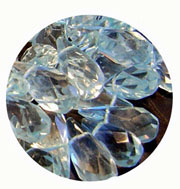 |
Shop Handmade
Blue Topaz Jewelry 
Blue Topaz comes in a variety of hues, from “London
Blue”, “Swiss Blue” and “Sky blue.”
The name Topaz is said to come from “tapas,” which
means fire in Sanskrit. One of the most famous
topazes, set in the Potuguese Braganza Crown, was
originally mistaken for a huge diamond.
The ancient Greeks believed Topaz had the power to
increase strength and make the wearer invisible.
Topaz was also reputed to assure beauty. Today
Topaz represents friendship, love, intelligence and is
believed to help cure insomnia.
Blue Topaz is mostly mined in Brazil, Pakistan, Sri
Lanka, and Nigeria. |
| |
|
| |
|
 |
Birthstone: July Moh's Hardness: 7 out of 10 |
|
 |
Shop Handmade
Carnelian Jewelry 
Carnelian carries a crimson orange-red tint and
comes from the chalcedony family.
“Carnelian” is said to be named after the Kornel
cherry, because of the color similarity. Discovered in
India in the fourth century A.D., the gemstone i s
believed to promotes self-esteem, strength, balance,
and creativity.
Carnelian is mined in Uruguay, Brazil and India. |
| |
|
| |
|
 |
Moh's Hardness: 6.5 out of 10 |
|
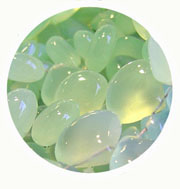 |
Shop Handmade
Chalcedony Jewelry 
Chalcedony is often called Cryptocrystalline Quartz
because it is comprised of tiny Quartz crystals that are
not visible to the eye. Utilized in jewelry for more than
3000 years, Chalcedony comes in many varieties and
colors.
Chalcedony varieties are believed to change bad
habits, prevent anger and encourage strength,
balance, and creativity.
Chalcedony is mined in a variety of countries,
including Brazil, Australia, India, the US, Uruguay, and
China. |
| |
|
| |
 |
Birthstone: November Moh's Hardness: 7.5 out of 10 |
|
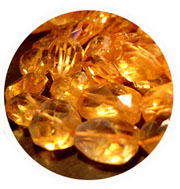 |
Shop Handmade
Citrine Jewelry 
Citrine ranges in color from yellow, gold to orange-brown shades. The name ‘citron” derives from the French word for lemon, “citron”.
Sometimes referred to as the “Stone of Wealth,” Citrine helps encourage prosperity.
Citrine is primarily mined in Brazil. |
|
| |
|
| |
|
 |
Moh's Hardness: 7 out of 10 |
|
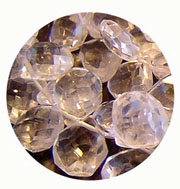 |
Shop Handmade
Clear Quartz Jewelry 
Clear and versatile, clear quartz is said to have the
clarity and shimmer of water.
The name “rock crystal” is derived from the gemstone’
s resemblance to compact forms of ice. In fact,
centuries ago people believed clear quartz was a form
of ice, leading to the name derivation from “crystallos”
which means "frozen.”
Over the years, clear quartz has become a popular
health and spiritual healer. Quartz is believed to be
good at soothing emotions, bringing mental clarity,
and promoting a healthy self-esteem.
This stone is mainly mined in Brazil, but also found in
Germany, Switzerland, and Japan. |
| |
|
| |
|
 |
Moh's Hardness: 3 out of 10 |
|
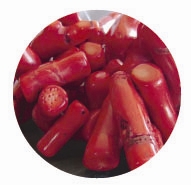 |
Shop Handmade
Coral Jewelry 
Corals are organic gems that grow deep within the
sea and are composed primarily of carbonic lime, just
like pearls.
The name Coral derives from the Greek word
“koraillon“ because of the hard and calcareous
resemblance to the coral animal skeleton. Some also
believe the name Coral derives from “kura-halos,”
which means mermaid.
Coral is believed to represent sunshine, summertime,
and the sea. It’s supposed to strike harmony between
wisdom and balance.
Corals are found primarily in Italy, Philippines, Japan,
Malaysia, the Mediterranean Sea, U.S., and Ireland. |
| |
|
| |
|
 |
Birthstone: April Moh's Hardness: 10 out of 10
Zodiac: Aries |
|
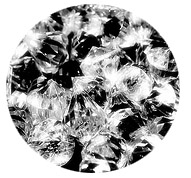 |
Shop Handmade
Diamond Jewelry 
Diamonds are prized
for their beauty and durability. A form of carbon, the Diamond is the
world’s hardest known natural material. In fact, the word “Diamond”
comes from the ancient Greek adamas, which means invincible.
Because of their
durability, Diamonds have been used in tools for since antiquity.
Diamonds were first used as religions icons in India nearly 2,500 years
ago. Since then, they've become highly coveted gemstones.
Diamonds are often
described and valued by their gemological characteristics: The Four C's
(carat, color, cut and clarity). Although Diamonds are used in many
types of fine jewelry, they are traditionally associated with engagement
and wedding rings.
Most people think
diamonds are white or colorless. In fact, yellow and brown Diamonds are
the most common. Any Diamond with a hue other than brown or yellow is
considered a colored Diamond. Colorless Diamonds are pure or nearly
pure. The color scale for colorless diamonds goes from D (colorless) to
Z (light yellow).
Almost half of all
Diamonds come from mines in central and southern Africa. The other half
comes from mines in Canada, India, Russia, Brazil and Australia.
Today, the jewelry
industry is buzzing about high-quality or lab-created diamonds. These
synthetic diamonds possess the same molecular structure as natural
diamonds. With public concerns about the mining industry, these man-made
beauties offer a compelling alternative to the real thing.
|
|
| |
|
| |
|
 |
Birthstone: January Moh's Hardness: 7 out of 10 |
|
 |
Shop Handmade
Garnet Jewelry 
Traditional garnet exhibits deep rich red or brownish-
red tones. Garnets in reality come in a variety of hues,
including yellow-green, pink-orange, brown, purple
and even blue.
The name “garnet” is derived from Latin, meaning
grain or seed, as the tiny red crystals were thought to
resemble seeds from the pomegranate. Popular
throughout the Middle Ages within the higher echelons
of society, garnets were favored by travelers who wore
them for protection.. Thousands of years earlier
Egyptian pharaohs viewed garnets as valuable prizes
to take to the afterlife. Christians believe Garnet was
used by Noah to guide the Ark.
Today, many believe garnets provide protection from
disease and promote feelings of peace, strength,
confidence, and productivity.
The majority of garnets come from sources in East
Africa, where the finest green garnets (called
“Tsavorites”) command prices comparative to the
precious Emerald. Other mine sources include
Central Europe, Russia and Brazil. |
| |
|
| |
|
 |
Moh's Hardness: 7 out of 10 |
|
 |
Shop Handmade
Grossular Garnet Jewelry 
The Grossular Garnet sports a light to dark
green/yellow glow, sometimes bordering on reddish-
orange; other times clear.
The name “garnet” means grain or seed in Latin.
Today, many believe garnets provide protection from
disease and promote feelings of peace, strength,
confidence and productivity.
Grossular Garnets are mined in Sri Lanka, Tanzania
and Kenya, among other places. |
| |
|
| |
|
 |
|
|
 |
Shop Handmade
Hessonite Garnet Jewelry 
Hessonite Garnet is a type of Grossular Garnet that
comes in shades of yellow and red bordering orange.
The name “garnet” is derived from Latin meaning
grain or seed, as the tiny crystals were thought to
resemble seeds from the pomegranate. Today,
garnets are still said to protect from diseases and
promote peace of spirit.
The gemstones are mined in Sri Lanka, Tanzania,
Kenya, and other nooks and crannies of the world. |
| |
|
| |
|
 |
Anniversary: 21st Moh's Hardness: 7.5 out of 10 |
|
 |
Shop Handmade
Iolite Jewelry 
Iolite, a naturally purple-blue gemstone, stands out
amongst its peers. A rich pleochroism, or showcase
of different colors in different directions in the crystal,
gives this gem a one-of-a-kind in appearance.
The name Iolite is derived from the Greek word “ios,”
which means violet. The pleochroic property in Iolite
led to the name "water sapphire." Because of its
pleochroism, Iolite can sometimes appear a deep
violet-blue from one direction, “clear as water” from
the other direction, and yellow from the top.
Iolite was used as a directional device when
legendary Viking explorers, such as Leif Eriksson,
went out into the Atlantic Ocean. The Vikings also
used Iolite as the world’s first polarizing filter, cutting
the stone into thin pieces. When they looked through
the Iolite lens, they could navigate their ships by the
exact position of the sun.
Iolite is believed to promote strength and confidence.
It is mainly mined in Sri Lanka, India, Brazil, and
Tanzania.
|
| |
|
| |
|
 |
Birthstone: March Moh’s hardness:
between 6.5 and 7.0
Zodiac: Aries
|
|
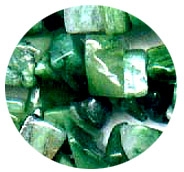 |
|
Shop Handmade
Jade Jewelry 
Jade is the name given to two different minerals: Nephrite and Jadeite.
Both minerals were brought to Europe from Asia and Central America and
it wasn’t until 1863 that they were distinguished from one another.
Jadeite is the more rare of the two minerals.
Jadeite, which can be bright emerald-green, pink, lavender and brown, is
an extremely durable mineral. It was used to make weapons and tools
before it became more valued for it’s ornamental properties. Nephrite is
either green or a creamy white color.
Jade's is often associated with Chinese cultural values like courage,
wisdom, mercy, justice, balance and love. Other associations include
health, wealth and longevity.
Today, Jade
large deposits of Jade can be found in British Columbia. |
|
| |
|
 |
Anniversary: 21st Moh's Hardness: 6.5 out of 10 |
|
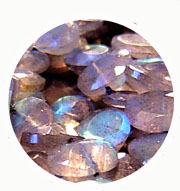 |
Shop Handmade
Labradorite Jewelry 
Labradorite, while grayish in tone, is unique with its
blue and green flashes. It displays the phenomena of
labradorescence, which creates a rainbow when light
reflects off the gem’s layers. Labrodorite typically has
black, gray, green, yellow, and brown tones. There are
many types of labradorite, including the rainbow
moonstone (a multi-colored adulerescence on white
body color), transparent labradorite (colorless and
yellow tones), and spectrolite.
Called the "Stone of New Beginnings," labradorite
builds strength and assists with life's transitions.
Labardorite is mined in Labrador, Canada. Other
sources include the United States, Finland, Kenya,
and Madagascar. |
| |
|
| |
|
 |
Birthstone: June Moh's Hardness: 6 out of 10 |
|
 |
Shop Handmade
Moonstone Jewelry 
The name “moonstone” comes from the shimmering
appearance of this gemstone. When the stone is
moved it changes color, a phenomenon called
“adularescence.” While to some this looks like a
magic trick, it really is the gem’s interior makeup.
Comprised of scales or lamellas, when hit by
incoming rays of light these scales refract and scatter
the beam.
Moonstone’s color comes in a large array of hues:
blues, green, orange and peaches, smoky beiges,
and brown; dependent on the origin of the stone.
Moonstone has long been considered a sacred and
magical gemstone. Centuries ago, the shimmering
adularescent property was thought to resemble the
phases of waxing and waning of the moon. In Arab
countries, moonstone was sewn into women’s
garments, as it symbolized fertility. In India,
moonstone was called the “dream stone,” as it was
believed to bring beautiful, sweet dreams. These
associations are what make Moonstone an ideal
choice for lovers, bringing forth feelings of tenderness
and true love. Last, it is also thought to bring about
mental clarity, balancing the ying-yang of the wearer.
Moonstone is mined in Sri Lanka, and India, as well
as Australia, Brazil, Madagascar, the United States
and Tanzania. |
| |
|
| |
| |
|
|
 |
|
Keishi Pearl |
| |
|
 |
|
Coin Pearl |
| |
|
 |
|
Freshwater Pearl |
|
Shop Handmade
Pearl Jewelry 
Pearls are said to be Aphrodites, "tears of joy."
Available in an array of colors, this underwater beauty
is undeniable. Pearls shimmer with the phenomena
that come from a living organism called a mollusk.
Pearls are not measured in carats, like so many other
gems--they are measured in millimeters round.
Cultured Pearls mean there has been human
intervention during the formation process. Natural
Pearls form without human intervention and are more
rare today. In cultured pearls there is a bead nucleus,
whereas natural pearls are formed only with the
layering ofnacre (the substance used to create
pearls) and have no bead nucleus.
Freshwater Pearls come from mussels and are
mainly from China. They first entered the market in the
1970’s. |
Keishi Pearls are byproducts of the cultured pearl
formation and form in both freshwater and saltwater
mollusks. The word "keshi" is derived from the
Japanese word that means poppy seed. Mollusks
sometimes get rid of an implanted bead nucleus but
keep the mantle-tissue and form pearl sacs. Either
way, the end-product is a lustrous and nearly rounded
shape of the keishi pearl.
South Sea Pearls are known for their soft, shiny luster
and are often set into well-matched strands,
displaying their incredible beauty. They are mainly
from Australia, where they range from 10-15mm. They
are also found in the Philippines and Indonesia.
Tahitian Pearls are mainly from the French Polynesian
Lagoons and the Cook Islands. They range from 8-
14mm round. The Tahitian Pearl colors are called
Peacock, Pistachio, and Aubergine; displaying
extraordinary colors.
Akoya Pearls are from China and Japan. Akoya is a
common word for oyster in Japanese. These pearls
range from 2-9mm.
Coin Pearls, also from Japan, are flat, disc-shaped
pearls that resemble that of a coin, and come in varied
large sizes.
Legend describes pearls as being "God's first
creation." Once considered an important factor in
marriage ceremonies during the 1920's, they were
Kirshna's wedding gift to his daughter. They’re also
said to have been the key ingredient to Cleopatra's
love potion. Pearls were at one time so valuable that
the General Vitellius from Rome financed his entire
military campaign on only one of his mother's pearl
earrings!
Pearls are said to promote wisdom, luck, wealth,
purity, and femininity, purity, and femininity.
|
| |
|
| |
|
 |
Birthstone: August Moh's Hardness: 6.5 out of 10 |
|
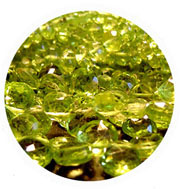 |
Shop Handmade
Peridot Jewelry 
Peridot, a yellowish green gemstone, is one of the
oldest and most popular gemstones. The name
Peridot is said to be derived from the Arabic word
“faridat,” meaning gem.
The gemstone is found in ancient Egyptian jewelry as
early as circa second millennium B.C. In ancient
times, peridots were used as currency and
accessories for the pharaohs.
Believed to glow in the dark like lanterns, peridot was
once only mined at night.
Peridots are believed to prevent fear and sadness,
break the power of evil spells, gain foresight into the
future, and give divine inspiration and wealth to the
wearer.
In the mid 1990’s, large, intense peridots were
discovered in the Pakistani mountains. They were
later called “cashmere quality,” reminiscent of
cashmere Sapphires. Peridot is also mined in the
United States, Australia, Sri Lanka, and Brazil, among
other places. |
| |
|
| |
|
 |
Moh's Hardness: 7 out of 10 |
|
 |
Shop Handmade
Rose Quartz Jewelry 
Rose Quartz is delicate pink in color. The gemstone
can range from a very light barely-there powder pink to
a medium dark pink and is semitransparent to
translucent in appearance.
People have used quartz in jewelry for centuries. They
are often associated with nobility and royalty.
Rose Quartz is believed to be good for expressing and
soothing emotions, balancing your yin yang and
promoting peace.
Rose Quartz is mainly mined in Brazil, Germany,
Switzerland, and Japan. |
| |
|
| |
|
 |
Birthstone: July Anniversary: 15th and 40th
Zodiac: Capricorn Moh's Hardness: 9 out of 10 |
|
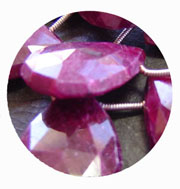 |
Shop Handmade
Ruby Jewelry 
Ruby is a variety of the species Corundum, and is one
of the most sought-after precious colored gems in the
world. The word ruby is said to come from the Latin
word “rubber” or “rubens,” which means red.
In ancient Sanskrit, ruby is called “ratnaraj,” or “king of
precious stones.” Centuries ago, people believed that
if a ruby were placed in a pot of water, it would cause
the water to boil. People also believed that if rubies
were placed beneath the skin, they would generate a
mystical force field that would protect the wearer from
mishaps. Red is also the color of blood--the life force
of all mankind.
Rubies became a popular colored stone among
European royalty and other nobility because of their
intense red color. Whenever a ruby was found, the
emperor/royalty sent out people to see and welcome
the precious stone. The ancient Hindus believed that
those who offered fine rubies to the God Krishna
could be granted the life of an emperor in their next
lives.
The ruby is often associated with the emotions of love,
passion, majesty, power and anger. Rubies are also
believed to open the heart, attract others, and
overcome fear. They were also said to help predict
the future if they change color or intensity.
Rubies were first mined 2500 years ago. While they
originated in Sri Lanka, today rubies are found in
Thailand, Mynamar, and Kenya. |
| |
|
| |
|
 |
Birthstone: September Moh's Hardness:
9 out of 10
Zodiac:
Libra, Capricorn |
|
 |
|
Shop Handmade
Sapphire Jewelry 
The beautiful blue
Sapphire is immaculate, pure and heavenly. Throughout history, the
Sapphire has been associated with qualities like sympathy, harmony,
friendship and loyalty, permanency and reliability. Not surprisingly, in
some cultures sapphires as more popular than diamonds as the center
stone for engagement rings.
The word “Sapphire”
comes from the Hebrew Sapir. Sapphires are most commonly blue,
but also occur as purple, yellow, orange, pink and green. These non-blue
stones are called “fancy sapphires.”
A Sapphire’s value is
determined by the richness and purity color of its color. Most Sapphires
are heat-treated to eliminate impurities and improve color and clarity.
Throughout history,
the majority of the world’s sapphires were mined in Sri Lanka,
Madagascar and Myanmar. Today, some of the finest Sapphires come from
mines in Montana.
|
|
| |
|
| |
|
 |
Moh's Hardness: 7 out of 10 |
|
 |
Shop Handmade Smokey Quartz Jewelry 
Smokey Quartz is the brown transparent variety of
quartz. This gem comes in many hues and
saturations, from a barely there pinkish-brown to a
deep red.
Smokey Quartz was once called “cairngorm,” named
after the Cairngorm Mountains of Scotland, where it
was mined and fashioned for a variety of uses.
Today many believe Smokey Quartz brings the wearer
mental clarity and enhances affection
Smokey Quartz is mined primarily in Brazil, Germany,
Switzerland, and Japan. |
| |
|
| |
|
 |
Birthstone: December Moh's Hardness:
6.5-7
out of 10
Zodiac:
Sagittarius |
|
 |
|
Shop Handmade
Tanzanite Jewelry 
The lovely violet-blue
tanzanite is relatively new player on the gemstone market. A blue
variety of the Zoisite gemstone, Tanzanite was discovered in Tanzania
(hence its name) in 1967. Tiffany's introduced Tanzanite to the general
public two years after its discovery.
Most tanzanite has
been heat treated to achieve its famous shimmering violet-blue color and
enhance its clarity.
The only source of
Tanzanite is a stretch of land south of the Kilimanjaro International
Airport in Tanzania. |
|
| |
|
| |
|
 |
Birthstone: October Anniversary: 8th
Zodiac: Leo Moh's Hardness: 7.5 out of 10 |
|
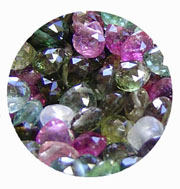 |
Shop Handmade
Tourmaline Jewelry 
The name "Tourmaline” comes from the Singhalese
expression "tura mali,” which means the "stone of
mixed colors.” Tourmalines are also known as the
“chameleon stone,” as they display an array of colors
similar to several other gemstones. Rubelite
Tourmaline, for example, is named after its ruby red
raspberry color. Some tourmalines can even display
two or more colors at once. Watermelon tourmaline,
for instance, is pink on the inside and rimmed with
green, just like the fruit itself. There are also varieties
of tourmalines that display color change when
exposed to different lighting.
In 1800, scientists realized that the tourmaline was a
different species altogether.
Tourmalines are believed to promote balance, love,
friendship, and protection. They are also said to help
with physical maladies and to bring wealth for the
wearer.
Tourmalines are found in Brazil, Afghanistan,
Myanmar, India, and Kenya. |
| |
|
| |
|
 |
Birthstone: December Anniversary: 11th |
|
 |
Shop Handmade
Turquoise Jewelry 
Turquoise has a cool disposition. The stone can
range from grey to green to blue to yellow and is often
veined by a brown matrix with varying textures. It is only
found in dry, barren regions.
Turquoise is one of the oldest stones used by man;
dating as far back as 6,000 years. Around 5500 BC,
the ancient Egyptians found Turquoise in the Sinai
Peninsula. When Queen Zer’s tomb, unearthed in
1900, revealed she was wearing a Turquoise and
gold bracelet around her wrist.
Turquoise is said to bring good luck. It’s also a
calming stone popular in Southwest, Native American,
and Egyptian jewelry designs.
Turquoise is mainly found in the US, Australia, Chile,
Mexico, and historically, Iran. |
| |
| |